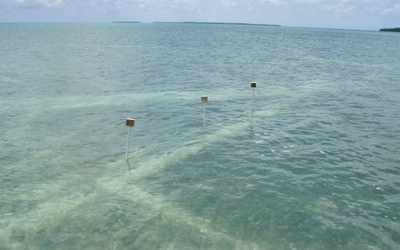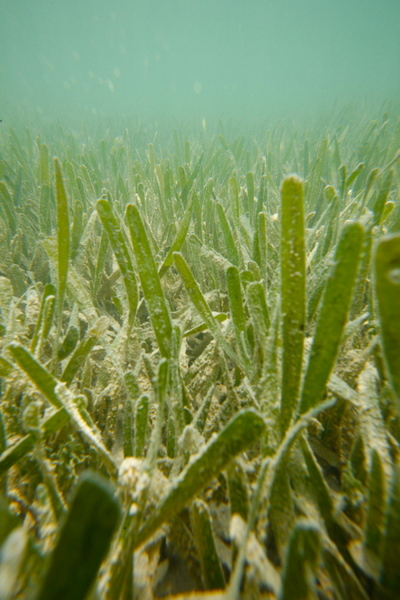By Captain Alan Sherman
Seagrasses can be found all over the world in shallow bays, lagoons, estuaries and along coastal waters. Where there is water there are boaters navigating these waters successfully and often times not so successfully. In most areas the water is deep enough for their propellers to cut through the water without causing any damage to the bottom below them but the unsuccessful boaters that stray away from their appropriate depth of water can cause significant damage to the beds of seagrasses often unaware of how much damage they have created. As the propellers of these vessels make contact with the fragile seagrasses the propellers cut into the soft sand or mud bottoms creating a trench that is deeper than the waters adjacent to the freshly cut trench. Besides the propeller cutting the trench the propeller also cuts the fragile seagrasses leaving this deeper trench void of all seagrasses. The damage created is called a propeller scar or prop trail. A propeller scar may be just a few feet in length but can also be hundreds of yards or more in length. Almost immediately erosion of these propeller scars starts to take place making the trails wider and deeper and creating cloudy water from tidal flow and wave action.
Seagrass meadows made up of one or many seagrasses such as turtle grass, shoal grass, manatee grass, star grass, widgeon grass, paddle grass and Johnson's sea grass are very important to the shallow bays, lagoons and coastal waters all over the world because these seagrasses help provide protective nurseries and food sources for many marine species. These seagrasses also increase water qualities in the areas of the seagrass meadows and reduce wave energy along the coastlines.
Columbia Sportswear, Bass Pro Shops and The Ocean Foundation have joined hands in an effort to restore seagrass meadows through education and habitat restoration.
Recently I was invited take part in a two day event sponsored by Columbia Sportswear, The Ocean Foundation, Seagrass Recovery, Andy Newman, Bass Pro Shops and George Poveromo. The event was put together to bring awareness to how serious these propeller scars can be to our fragile bays, lagoons, shallow coastal waters and estuaries. During the event I had the opportunity to see firsthand propeller scars that had been accidently cut into fragile seagrass flats in Florida Bay off of Islamorada and then I got to take part in the actual repair of one of these propeller scars.
With the guidance of the Seagrass Recovery project representatives, Kenny Wright and Beau Williams I was able to take part in repairing a propeller scar. Once at the sight of a propeller scar located just a few minutes from Wide World Sportsman in Islamorada it was quite obvious how bad a propeller scar actually is. I looked out on the beautiful green grass meadow only to see this horrific looking white stripe that had been cut into the meadow by a boater who thought there was more water under the propeller than there actually was. We anchored our boat and I donned a mask and snorkel and jumped into the crystal clear water that was just two feet deep. As I snorkeled the barren propeller scar it was obvious that the scar was deeper then the water surrounding it and that the seagrasses on the edge of that scar couldn't grow into the trench. This scar was fairly new and had not grown much since the propeller scar had been created. Others joined me and then we started the repair of the propeller scar.
First four foot biodegradable sediment tubes were place one at a time into the propeller scar. Once the propeller scar had been filled with these biodegradable sediment tubes long pieces of PVC tubing with wooden stands attached to the tops of the tube were driven into the ground and spaced out along the biodegradable sediment tubes. These biodegradable sediment tubes over the course of time will break down and completely fill the propeller scar bringing the depth of that scar back to its original level. The PVC tubes and stands are there to attract birds that will come and sit on the stands and eventually fertilize the area around the propeller scar with their guano. Three months after the biodegradable sediment tubes have been placed in the propeller scar, a crew from Seagrass Recovery will visit the site and plant seagrass plugs that were retrieved off the sea surface into the restored propeller scar. Twelve to eighteen months later the propeller scar will have been totally restored.



